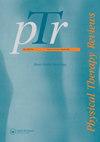Training parameters and effects of high-intensity interval training in patients with spinal cord injury: a review of literature
IF 0.8
Q4 REHABILITATION
引用次数: 0
Abstract
Abstract Background Inactivity among patients with spinal cord injury causes further deterioration of cardiorespiratory function and muscle strength. A variety of exercise modes, including high-intensity interval training (HIIT), have been applied to this population to aid them in maintaining good physical and mental health. However, an extensive review of the training parameters and efficacy of HIIT in patients with spinal cord injury remains lacking. Objectives This review aims to summarize the training parameters and effects of HIIT on cardiorespiratory function, muscle architecture, and strength among patients with spinal cord injury. Methods All studies were identified from electronic databases from 2005 to 2020. All articles were reviewed, and data were extracted independently by two reviewers. Risk of bias was assessed using the NIH Quality Assessment Tool for Before-After (Pre-Post) Studies with No Control Group. The methodological quality of randomized control trial (RCT) studies was measured using the PEDro scale. Results A total of 305 studies were identified from all listed databases. After screening, twelve experimental studies comprising three case studies, six quasi-experimental, and three RCTs were selected. Four studies were rated as good, and two studies were rated as fair for the methodology quality of the quasi-experimental study. All three RCT studies scored 5/10 or higher on the PEDro scale. A wide range of training parameters were found for HIIT training. Improvement of VO2peak was reported in seven studies. Information on the effect of HIIT on muscle strength was limited and inconclusive. Conclusion Despite limited evidence, HIIT could be considered effective in improving cardiorespiratory fitness in patients with spinal cord injury. However, whether or not HIIT can significantly improve muscle strength among this population remains inconclusive because of insufficient quality evidence.脊髓损伤患者高强度间歇训练的训练参数及效果:文献综述
摘要背景脊髓损伤患者的不活动导致心肺功能和肌肉力量的进一步恶化。包括高强度间歇训练(HIIT)在内的各种锻炼模式已被应用于这一人群,以帮助他们保持良好的身心健康。然而,对HIIT在脊髓损伤患者中的训练参数和疗效仍缺乏广泛的综述。目的总结HIIT对脊髓损伤患者心肺功能、肌肉结构和力量的训练参数和影响。方法所有研究均来自2005年至2020年的电子数据库。所有的文章都经过了评审,数据由两位评审员独立提取。使用NIH质量评估工具对无对照组的前后研究进行偏倚风险评估。随机对照试验(RCT)研究的方法学质量使用PEDro量表进行测量。结果从所有列出的数据库中总共确定了305项研究。筛选后,选择了12项实验研究,包括3项案例研究、6项准实验研究和3项随机对照试验。四项研究被评为良好,两项研究被评定为准实验研究的方法论质量尚可。所有三项随机对照试验的PEDro量表得分均为5/10或更高。为HIIT培训找到了广泛的培训参数。七项研究报告了VO2峰值的改善。关于HIIT对肌肉力量影响的信息是有限的,并且没有结论。结论尽管证据有限,HIIT在改善脊髓损伤患者心肺功能方面仍然有效。然而,由于质量证据不足,HIIT是否能显著提高这一人群的肌肉力量仍不确定。
本文章由计算机程序翻译,如有差异,请以英文原文为准。
求助全文
约1分钟内获得全文
求助全文
来源期刊

Physical Therapy Reviews
REHABILITATION-
CiteScore
1.30
自引率
0.00%
发文量
26
期刊介绍:
Physical Therapy Reviews is an international journal which aims to publish contemporary reviews, discussion papers and editorials within physical therapy, and in those basic and clinical sciences which are the basis of physical therapy. The journal is aimed at all those involved in research, teaching and practice within the area of physical therapy. Reviews (both descriptive and systematic) are invited in the following areas, which reflect the breadth and diversity of practice within physical therapy: •neurological rehabilitation •movement and exercise •orthopaedics and rheumatology •manual therapy and massage •sports medicine •measurement •chest physiotherapy •electrotherapeutics •obstetrics and gynaecology •complementary therapies •professional issues •musculoskeletal rehabilitation
 求助内容:
求助内容: 应助结果提醒方式:
应助结果提醒方式:


